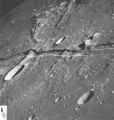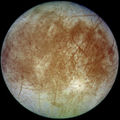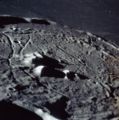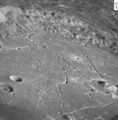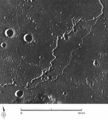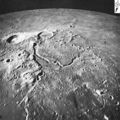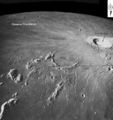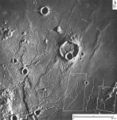Moon Split Images
|
WikiIslam Archive,
Archives of the first iteration of WikiIslam, prior to acquisition and revamp by Ex-Muslims of North America
|
This article analyzes the apologetic claim that there is photographic evidence to support the Muslim belief that Prophet Muhammad split the moon.
Contents
Apologetic Claim
Many Muslims believe that while Muhammad was in Mecca, Allah split the moon as a miracle for Muhammad to the Meccans.
Today, this has lead to some Muslims claiming that there is photographic evidence to support this belief. To back up their claim, most use the following close-up pictures of the moon:
Origin
In 2007, Dr. Zaghloul El Najjar used these photos to circulate the claim that NASA had proven the Moon had split,[1] a claim that was further propagated by news services such as Jafariya News.[2] Today, due to its popularity, the same claim can be found on countless Islamic websites.
Analysis
Lunar Rilles
The "spilt" you see is in fact a lunar rille. Rilles are long and deep gorges resembling canyons. A rille is typically several kilometers wide and hundreds of kilometers in length. Similar formations are found on a number of planets in the solar system, including Mars, Venus, and on a number of moons.
How these rilles are formed is still not known with certainty. Theories include erosion at some point in the stellar body's history, collapsed lava tubes, and tectonic activity/stresses.
Types of Rilles
There are three types of rilles on the lunar surface:
- Sinuous rilles meander in a curved path like a river, and are commonly thought to be the remains of collapsed lava tubes or extinct lava flows. They usually begin at an extinct volcano, then meander and sometimes split as they are followed across the surface.
- Arcuate rilles have a smooth curve and are found on the edges of the dark lunar maria. They are believed to form when the lava flows that created a mare cools, contracts, and sinks.
- Straight rilles follow long, linear paths and are believed to be grabens. That is, a section of the crust that has sunk between two parallel faults. These can be readily identified when they pass through craters or mountain ranges.
Rilles can be found all over the lunar surface and they do not form a belt and therefore do not in anyway support the claim of Muslims that the moon had been split asunder.
Images of Rilles
To understand how rilles scar the surface of the moon, we have to take a look at pictures showing the moon from farther up. Do these gorges look like they are cutting the moon in two halves?
Rima Ariadaeus
The images used by Muslims are Apollo mission photographs of a rille named Rima Ariadaeus. It is found on the Moon at 6.4°N 14.0°E, and is named after the crater Ariadaeus, which marks its eastern end. It is a linear rille which is only about 300km long and barely covers 3% of the Moon's circumference.
NASA scientists Speak Out
NASA scientists have stated that no evidence exists to support the claim of the Moon being split into two or more parts in the past. In 2010, NASA scientist Brad Bailey commented, "My recommendation is to not believe everything you read on the internet. Peer-reviewed papers are the only scientifically valid sources of information out there. No current scientific evidence reports that the Moon was split into two (or more) parts and then reassembled at any point in the past."[3]
See Also
- Moon Split Miracle - A hub page that leads to other articles related to the Moon Split Miracle
External Links
- Rima Ariadaeus - Wikipedia, September 14, 2012
- Moon Split Miracle Chain Letter - Brett Christensen, Hoax-Slayer, September 7, 2010
References
- ↑ Dr. Zaghloul El-Naggar, "The Moon Cleft Asunder", Elnaggarzr.com, Archive.org capture dated October 26, 2007 (archived), http://web.archive.org/web/20071026053311/http://www.elnaggarzr.com/en/main.php?id=31.
- ↑ Mohamed Ali, "Crack on moon confirms Prophet Muhammad (S) had split it", Jafariya News, March 22, 2008 (archived), http://www.jafariyanews.com/2k8_news/march/22moon_crack.htm.
- ↑ Brad Bailey, "Evidence of the moon having been split in two", NASA Lunar Science Institute, June 21, 2010 (archived), http://lunarscience.nasa.gov/?question=evidence-moon-having-been-split-two.
